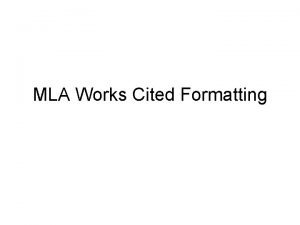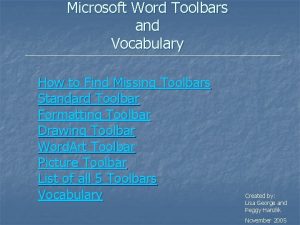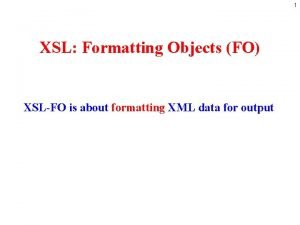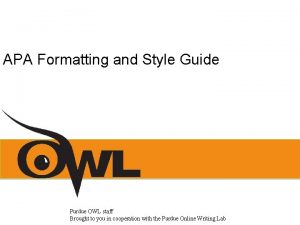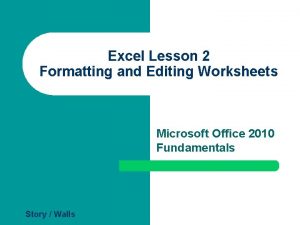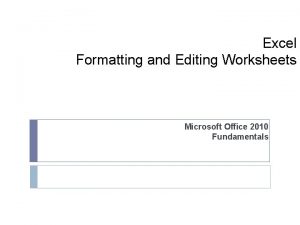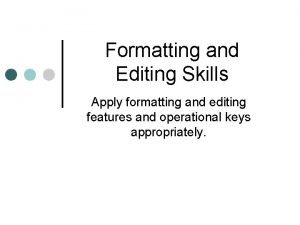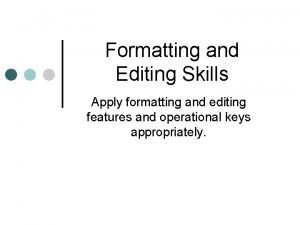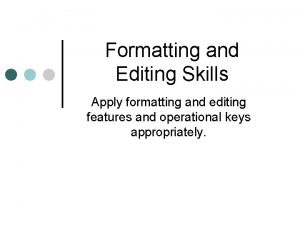Excel Lesson 2 Formatting and Editing Worksheets Microsoft
























- Slides: 24

Excel Lesson 2 Formatting and Editing Worksheets Microsoft Office 2010 Fundamentals Story / Walls

Objectives l Excel Lesson 2 l l l l 2 Create a new workbook. Format cells. Apply themes and styles and use conditional formatting. Adjust column widths and row heights. Insert and delete rows and columns. Find and replace data. Copy and move worksheet data. Check spelling. Story / Walls MS Office 2010 Fundamentals

Vocabulary l Excel Lesson 2 l l l 3 cell style Clipboard conditional formatting copy cut drag-and-drop method Story / Walls l l l fill font styles paste point size theme MS Office 2010 Fundamentals

http: //mjiang. com/mecps/tech/office 2 010/Excel/ Excel Lesson 2 l 4 l In this lesson, you will learn how to use Excel’s editing and formatting features to enhance the appearance of a worksheet. You will also learn how to create a new workbook; how to format a workbook; and how to organize data to get the information you need. Story / Walls MS Office 2010 Fundamentals

Creating a New Workbook Excel Lesson 2 l 5 Create a new workbook by clicking the File tab to display Backstage view, then clicking New. Click the Blank workbook icon in the center pane and then click the Create button. Story / Walls MS Office 2010 Fundamentals

Formatting Cells Excel Lesson 2 l 6 Click the dialog box launcher in the Font, Alignment, or Number groups on the Home tab to display the Format Cells dialog box. Story / Walls MS Office 2010 Fundamentals

Formatting Cells (continued) l Excel Lesson 2 l 7 Setting Font Formats: The Font group on the Home tab on the Ribbon includes options for selecting fonts, font size, underline, and font color. Story / Walls MS Office 2010 Fundamentals

Formatting Cells (continued) l Excel Lesson 2 l l l 8 Using the Format Painter: You can use the Format Painter to copy multiple formatting characteristics at once to other cells. Adding and Removing Cell Borders: Borders can be applied to any side of a cell using predefined styles or by creating custom borders. Changing Fill Color: To change a cell’s background color, use the Fill Color button in the Font group on the Home tab. Story / Walls MS Office 2010 Fundamentals

Formatting Cells (continued) l Excel Lesson 2 l 9 l l Changing Cell Alignment: Use the buttons in the Alignment group on the Home tab. More options are located on the Alignment tab of the Format Cells dialog box. Clearing Cell Formats: Remove all the formatting from a cell or range by clicking the Clear button on the Home tab in the Editing group and then clicking Clear Formats. Story / Walls MS Office 2010 Fundamentals

Formatting Cells (continued) l Excel Lesson 2 l 10 Applying Number Formats: To change a number format, use the buttons found on the Home tab in the Number group. Story / Walls MS Office 2010 Fundamentals

Applying Themes and Styles l Excel Lesson 2 l 11 l Applying Themes: A theme is a set of predesigned formatting elements—including colors, fonts, and effects. Use the commands in the Themes group on the Page Layout tab. Story / Walls MS Office 2010 Fundamentals

Applying Themes and Styles (continued) Excel Lesson 2 l 12 l Working with Table Styles: Click the Format as Table button in the Styles group on the Home tab to display a gallery of table styles. Story / Walls MS Office 2010 Fundamentals

Applying Themes and Styles (continued) l Excel Lesson 2 l 13 l Applying Cell Styles: A defined combination of formatting characteristics—such as number, alignment, font, border, and fill—is called a cell style. Click the Cell Styles button in the Styles group on the Home tab to display a gallery of cell styles. Story / Walls MS Office 2010 Fundamentals

Using Conditional Formatting Click the Conditional Formatting button on the Home tab in the Styles group. Excel Lesson 2 l 14 Story / Walls MS Office 2010 Fundamentals

Working with Rows and Columns Excel Lesson 2 l 15 The commands for inserting, deleting, and resizing rows and columns are located in the Cells group on the Home tab. Story / Walls MS Office 2010 Fundamentals

Working with Rows and Columns (continued) l Excel Lesson 2 l 16 Adjusting Column Width: Use the mouse to drag the right border of the column heading to the width you want. Or specify an exact width in the Column Width dialog box by clicking the Format button in the cells group on the Home tab. Story / Walls MS Office 2010 Fundamentals

Working with Rows and Columns (continued) l Excel Lesson 2 l 17 l Adjusting Row Height: Excel changes the row height automatically to accommodate the data and font size. When necessary, you can click the row heading border and drag up or down to a new height. Story / Walls MS Office 2010 Fundamentals

Working with Rows and Columns (continued) l Excel Lesson 2 l 18 l l Inserting a Row or Column: Click the Insert button arrow in the Cells group on the Home tab to display a menu with options for inserting a row or a column. Deleting a Row or Column: Click the Delete button arrow in the Cells group on the Home tab to display a menu with options for deleting rows or columns. Story / Walls MS Office 2010 Fundamentals

Finding and Replacing Data Excel Lesson 2 l 19 Click the Find & Select button in the Editing group on the Home tab to access the Find and Replace commands. Story / Walls MS Office 2010 Fundamentals

Copying and Moving Worksheet Data Excel Lesson 2 l 20 l l To move or copy data, you can use the Clipboard or the drag-and-drop method. Cutting, Copying, and Pasting to the Clipboard: The Cut, Copy, and Paste buttons are located in the Clipboard group on the Home tab. Story / Walls MS Office 2010 Fundamentals

Copying and Moving Worksheet Data (continued) l Excel Lesson 2 l 21 Using the Drag-and-Drop Method: Use the mouse to click a selected cell or range, drag it to a new location, and drop it. Story / Walls MS Office 2010 Fundamentals

Checking Spelling Excel Lesson 2 l 22 Click the Spelling button in the Proofing group on the Review tab to open the Spelling dialog box. Story / Walls MS Office 2010 Fundamentals

Excel Lesson 2 Summary 23 In this lesson, you learned: l How to create new workbooks. l Various ways to format cells. l How to apply themes and styles. l Conditional formatting can help highlight and interpret data. Story / Walls MS Office 2010 Fundamentals

Summary (continued) Excel Lesson 2 l 24 l l l The processes for adjusting column widths and row heights. Methods of inserting and deleting rows and columns. How to find, replace, copy, and move worksheet data. It is a good idea to check spelling. Story / Walls MS Office 2010 Fundamentals
 Editing and formatting text
Editing and formatting text What is an unqualified structured reference in excel
What is an unqualified structured reference in excel Data preparation process in research methodology
Data preparation process in research methodology Nonlinear video editing
Nonlinear video editing Weather in excel
Weather in excel Microsoft official academic course microsoft excel 2016
Microsoft official academic course microsoft excel 2016 Excel merupakan aplikasi
Excel merupakan aplikasi Read and write mechanism of magnetic disk
Read and write mechanism of magnetic disk Quote citation
Quote citation Mla format title page
Mla format title page Owl mla work cited
Owl mla work cited Word toolbars
Word toolbars Modified formal style
Modified formal style Apache fop
Apache fop What is apa formatting style
What is apa formatting style Xslfo
Xslfo Monologue format
Monologue format Gambar toolbar formatting
Gambar toolbar formatting Gambar toolbar formatting
Gambar toolbar formatting Sqlplus format output
Sqlplus format output Which microsoft word tab contains the print command? *
Which microsoft word tab contains the print command? * Formatting in digital communication
Formatting in digital communication Sqlplus report formatting
Sqlplus report formatting Apa 7 purdue owl
Apa 7 purdue owl Pascal writeln formatting
Pascal writeln formatting










